Black (Grey) Angelfish, Size 4.5 – 5.5 inches
Pomacanthus arcuatus
$566.99 Original price was: $566.99.$354.99Current price is: $354.99.
Pomacanthus arcuatus, also known as the Blueface angelfish, is a species of marine fish that is found in the tropical Western Atlantic Ocean. It is a member of the Pomacanthidae family, which includes other angelfish species. The Blueface angelfish is a large fish that can reach up to 40 centimeters (16 inches) in length. They are typically blue-gray in color with a distinctive yellow face, hence their common name. They have a white ring around their eyes and may have blue or black spots on their dorsal and anal fins. These fish are typically found in rocky reef environments and are known to be territorial. They feed on a variety of invertebrates, including sponges, tunicates, and corals. Blueface angelfish are popular in the marine aquarium trade and are considered to be hardy fish suitable for experienced aquarists.
Only 1 left in stock
Black (Grey) Angelfish – (Pomacanthus arcuatus)
Quick Stats:
- Care Level: Moderate
- Temperament: Semi-aggressive
- Diet: Omnivorous
- Reef Safe: No
- Minimum Tank Size: 100 gallons
- Maximum Size: Up to 15 inches
- Water Parameters: pH 8.1-8.4, Salinity 1.020-1.025, Temperature 72-78°F
Comprehensive Guide: Black (Grey) Angelfish – (Pomacanthus arcuatus)
The Black Angelfish, also known as the Grey Angelfish, is a beautiful and popular species in the saltwater aquarium hobby. This comprehensive guide will provide you with all the necessary information to successfully care for this species in your saltwater aquarium.
Habitat
The Black Angelfish is found in the Indo-Pacific region, specifically around the reefs of the Indian Ocean and the West Pacific Ocean. They inhabit areas with rocky and coral-rich environments, often seen swimming in pairs or small groups.
Reef Safe
The Black Angelfish is not considered reef safe. They have a tendency to nip at corals and other sessile invertebrates, which can cause damage to a reef tank. It is best to keep them in a fish-only or predator tank.
Size
The Black Angelfish can grow up to 15 inches in length, making it a relatively large angelfish species. It is important to provide them with a spacious tank to accommodate their size.
Temperament
The Black Angelfish has a semi-aggressive temperament. While they are generally peaceful towards other fish, they may become territorial and aggressive towards smaller or similar-sized tankmates. It is best to choose tankmates that can hold their own against the Black Angelfish.
Sexual Dimorphism
There is no visible difference in appearance between male and female Black Angelfish. They are monomorphic, meaning they have similar physical characteristics regardless of gender.
Lifespan
The Black Angelfish has an average lifespan of 10 to 15 years when kept in optimal conditions. With proper care and a suitable environment, they can live even longer.
Diet in Aquariums
The Black Angelfish is an omnivorous species. In the wild, they feed on a variety of algae, small invertebrates, and zooplankton. In the aquarium, their diet should consist of a combination of high-quality pellets, frozen foods (such as brine shrimp and mysis shrimp), and occasional vegetable matter. Providing a varied diet will ensure they receive all the necessary nutrients.
Aquascaping Recommendations
When it comes to aquascaping, the Black Angelfish prefers a tank with plenty of hiding spots and caves. They appreciate the presence of live rock, which provides them with natural hiding places and opportunities to graze on algae. It is also important to provide open swimming areas for them to roam around.
Captive Bred Availability
The Black Angelfish is occasionally available as captive-bred specimens. However, the majority of individuals available in the aquarium trade are wild-caught. Captive-bred specimens are often preferred as they tend to be hardier and less prone to diseases.
Compatibility with Other Fish, Invertebrates, or Corals
Due to their semi-aggressive temperament and potential for nipping at corals, the Black Angelfish should be kept with caution when it comes to tankmates. Here are five specific tankmates that are generally considered good choices:
- Naso Tang: The Naso Tang is a larger fish that can handle the Black Angelfish’s semi-aggressive behavior. They also occupy different areas of the tank, reducing the likelihood of territorial disputes.
- Majestic Angelfish: The Majestic Angelfish is a visually stunning species that is known for its peaceful nature. They can coexist with the Black Angelfish as long as the tank is large enough.
- Blue Tang: The Blue Tang is a popular and colorful fish that can tolerate the semi-aggressive behavior of the Black Angelfish. They are commonly found together in the wild.
- Yellowtail Damsel: The Yellowtail Damsel is a small and hardy fish that can hold its own against the Black Angelfish. They are less likely to be bothered by its presence.
- Peppermint Shrimp: The Peppermint Shrimp is a small invertebrate that can help control unwanted pests in the tank. They are generally safe from the Black Angelfish’s aggression.
These are just a few examples, and compatibility can vary depending on the individual fish and the specific tank setup. It is always recommended to research each potential tankmate’s compatibility and monitor their interactions closely.
Other Common Names
The Black Angelfish is also commonly known as the Grey Angelfish, Gray Angelfish, and Black Emperor Angelfish.
Why Buy from Reefs4Less.com?
Reefs4Less.com is a reputable online retailer specializing in saltwater aquarium supplies and livestock. They offer a wide selection of high-quality fish and corals, including the Black Angelfish. Here are a few reasons why you should consider buying from them:
- Wide Selection: Reefs4Less.com has a diverse range of marine fish and corals, allowing you to find the perfect addition to your aquarium.
- Quality Assurance: They take great care in selecting healthy and vibrant specimens, ensuring you receive healthy fish and corals.
- Shipping and Packaging: Reefs4Less.com utilizes industry-standard practices for packaging and shipping, ensuring your livestock arrives safely and in good condition.
- Customer Support: They have a knowledgeable and friendly customer support team that can assist you with any questions or concerns you may have.
- Convenience: With Reefs4Less.com, you can conveniently browse and purchase marine fish and corals from the comfort of your own home.
Popular Questions and Answers
- Q. Can the Black Angelfish be kept in a reef tank?
No, the Black Angelfish is not considered reef safe. They have a tendency to nip at corals and other sessile invertebrates, which can cause damage to a reef tank. - Q. How big can the Black Angelfish grow?
A. The Black Angelfish can grow up to 15 inches in length, making it a relatively large angelfish species. - Q. How long do Black Angelfish typically live?
A. The Black Angelfish has an average lifespan of 10 to 15 years when kept in optimal conditions. - Q. What should I feed my Black Angelfish in the aquarium?
A. The diet of the Black Angelfish in the aquarium should consist of a combination of high-quality pellets, frozen foods (such as brine shrimp and mysis shrimp), and occasional vegetable matter. - Q. Are there any specific tankmates that are good companions for the Black Angelfish?
A. Yes, some good tankmates for the Black Angelfish include Naso Tang, Majestic Angelfish, Blue Tang, Yellowtail Damsel, and Peppermint Shrimp. These choices are based on their ability to tolerate the semi-aggressive behavior of the Black Angelfish.
| Size | 5.25 – 6.25 inches |
|---|

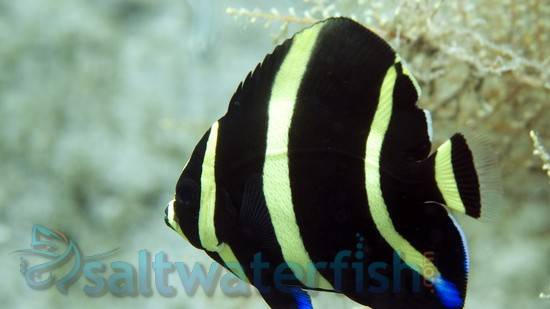
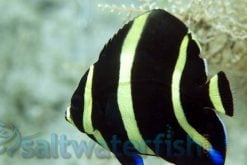
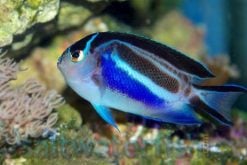
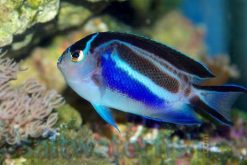
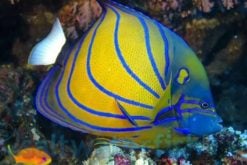
Reviews
There are no reviews yet.